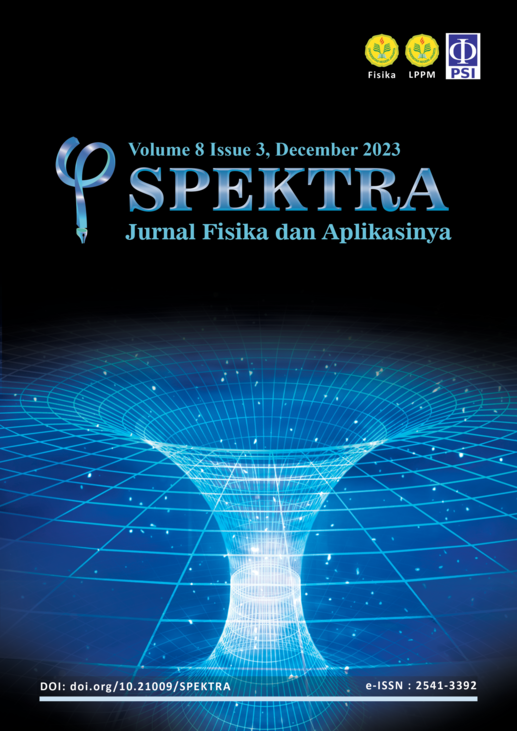RICE SAMPLE VAPORIATION METHOD ON METER TESTING RESISTIVE WATER CONTENT BASED ON ULTRASONIC MIST
DOI:
https://doi.org/10.21009/SPEKTRA.083.03Keywords:
moisture content, ultrasonic mist, evaporationAbstract
Percentage moisture content is an important factor in assessing the quality and quantity of agricultural commodities, such as rice. The measurement of moisture content is very important to evaluate the moisture content of rice, which directly affects its quality. However, the measurement of moisture content takes a long time, so it is necessary to have an evaporation method to shorten the time so that the moisture content of the sample is as required. In this study, the method chosen was the evaporation method with ultrasonic mist. The results showed that this ultrasonic fog controller evaporation system successfully increased the moisture content of rice samples according to the criteria needed to be used in resistive-type moisture meter testing. The ultrasonic mist controller evaporation system can increase the water content of rice samples according to the criteria needed for use in resistive-type moisture meter testing, with an average increase of 0.9% within 15 minutes, 3.4% within 30 minutes, and 4.1% within 1 hour.
References
[2] S. M. Abdullah et al., “Design and Development of RTI System for Moisture Content Localization in Rice Silo,” 2022, https://doi.org/10.21203/rs.3.rs-1390879/v1.
[3] J. Liu, S. Qiu, Z. Wei, “Real-Time Measurement of Moisture Content of Paddy Rice Based on Microstrip Microwave Sensor Assisted by Machine Learning Strategies,” Chemosensors, vol. 10, no. 10, 2022, https://doi.org/10.3390/chemosensors10100376.
[4] S. Huang et al., “Dry-to-wet fluctuation of moisture contents enhanced the mineralization of chloramphenicol antibiotic,” Water Research, vol. 240, p. 120103, 2023, https://doi.org/10.1016/J.WATRES.2023.120103.
[5] E. Susilowati, M. Alamsjah and D. Pujiastuti, “The effect of old water making time and heating temperature on moisture content and NaCl on traditional salt production,” IOP Conference Series: Earth and Environmental Science, vol. 1273, no. 1, p. 012028, 2023, https://doi.org/10.1088/1755-1315/1273/1/012028.
[6] H. J. Sarnavi et al., “Determining the heat of desorption for cassava products based on data measured by an automated gravimetric moisture sorption system,” Journal of the Science of Food and Agriculture, vol. 103, no. 1, pp. 389-399, 2023, https://doi.org/10.1002/jsfa.12153.
[7] W. Feng et al., “Effects of biochar on soil evaporation and moisture content and the associated mechanisms, Environmental Sciences Europe, vol. 35, no. 1, 2023, https://doi.org/10.1186/s12302-023-00776-7.
[8] A. Patel et al., “Measurement of Moisture Content in Pharmaceutical Tablets by Handheld Near-Infrared Spectrometer: Adopting Quality by Design Approach to Analytical Method Lifecycle Management,” Journal of Pharmaceutical and Biomedical Analysis, vol. 229, p. 115381, 2023, https://doi.org/10.1016/J.JPBA.2023.115381.
[9] T. Kudo et al., “Effect of ultrasonic frequency on size distributions of nanosized mist generated by ultrasonic atomization,” Ultrasonics Sonochemistry, vol. 37, pp. 16-22, 2017, https://doi.org/10.1016/J.ULTSONCH.2016.12.019.
[10] A. C. Chang, “Study of ultrasonic wave treatments for accelerating the aging process in a rice alcoholic beverage,” Food Chemistry, vol. 92, no. 2, pp. 337-342, 2005, https://doi.org/10.1016/J.FOODCHEM.2004.07.027.
[11] P. Martínez et al., “Experimental study of an ultrasonic mist generator as an evaporative cooler,” Applied Thermal Engineering, vol. 181, p. 116057, 2020, https://doi.org/10.1016/J.APPLTHERMALENG.2020.116057.
Downloads
Published
How to Cite
Issue
Section
License
SPEKTRA: Jurnal Fisika dan Aplikasinya allow the author(s) to hold the copyright without restrictions and allow the author(s) to retain publishing rights without restrictions. SPEKTRA: Jurnal Fisika dan Aplikasinya CC-BY or an equivalent license as the optimal license for the publication, distribution, use, and reuse of scholarly work. In developing strategy and setting priorities, SPEKTRA: Jurnal Fisika dan Aplikasinya recognize that free access is better than priced access, libre access is better than free access, and libre under CC-BY or the equivalent is better than libre under more restrictive open licenses. We should achieve what we can when we can. We should not delay achieving free in order to achieve libre, and we should not stop with free when we can achieve libre.
 SPEKTRA: Jurnal Fisika dan Aplikasinya is licensed under a Creative Commons Attribution 4.0 International License.
SPEKTRA: Jurnal Fisika dan Aplikasinya is licensed under a Creative Commons Attribution 4.0 International License.
You are free to:
Share - copy and redistribute the material in any medium or format
Adapt - remix, transform, and build upon the material for any purpose, even commercially.
The licensor cannot revoke these freedoms as long as you follow the license terms.

 E-ISSN 2541-3392
E-ISSN 2541-3392  Focus & Scope
Focus & Scope  Editorial Team
Editorial Team  Reviewer Team
Reviewer Team  Author Guidelines
Author Guidelines  Article Template
Article Template  Author Fee
Author Fee  Publication Ethics
Publication Ethics  Plagiarism Policy
Plagiarism Policy  Open Access Policy
Open Access Policy  Peer Review Process
Peer Review Process  Retraction & Correction
Retraction & Correction  Licensing & Copyright
Licensing & Copyright  Archiving & Repository
Archiving & Repository  Contact
Contact  Mendeley
Mendeley 

